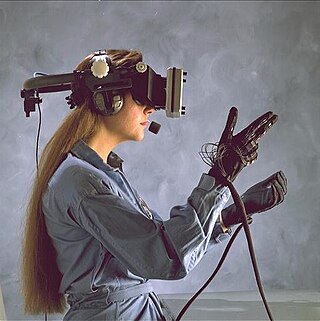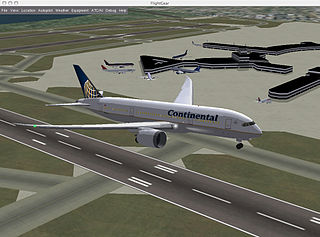Related Research Articles

Virtual reality (VR) is a simulated experience that employs pose tracking and 3D near-eye displays to give the user an immersive feel of a virtual world. Applications of virtual reality include entertainment, education and business. Other distinct types of VR-style technology include augmented reality and mixed reality, sometimes referred to as extended reality or XR, although definitions are currently changing due to the nascence of the industry.

A simulation is an imitative representation of a process or system that could exist in the real world. In this broad sense, simulation can often be used interchangeably with model. Sometimes a clear distinction between the two terms is made, in which simulations require the use of models; the model represents the key characteristics or behaviors of the selected system or process, whereas the simulation represents the evolution of the model over time. Another way to distinguish between the terms is to define simulation as experimentation with the help of a model. This definition includes time-independent simulations. Often, computers are used to execute the simulation.

Laparoscopy is an operation performed in the abdomen or pelvis using small incisions with the aid of a camera. The laparoscope aids diagnosis or therapeutic interventions with a few small cuts in the abdomen.

Haptic technology is technology that can create an experience of touch by applying forces, vibrations, or motions to the user. These technologies can be used to create virtual objects in a computer simulation, to control virtual objects, and to enhance remote control of machines and devices (telerobotics). Haptic devices may incorporate tactile sensors that measure forces exerted by the user on the interface. The word haptic, from the Greek: ἁπτικός (haptikos), means "tactile, pertaining to the sense of touch". Simple haptic devices are common in the form of game controllers, joysticks, and steering wheels.
Remote surgery is the ability for a doctor to perform surgery on a patient even though they are not physically in the same location. It is a form of telepresence. A robot surgical system generally consists of one or more arms, a master controller (console), and a sensory system giving feedback to the user. Remote surgery combines elements of robotics, telecommunications such as high-speed data connections and elements of management information systems. While the field of robotic surgery is fairly well established, most of these robots are controlled by surgeons at the location of the surgery. Remote surgery is remote work for surgeons, where the physical distance between the surgeon and the patient is less relevant. It promises to allow the expertise of specialized surgeons to be available to patients worldwide, without the need for patients to travel beyond their local hospital.

Computer-mediated reality refers to the ability to add to, subtract information from, or otherwise manipulate one's perception of reality through the use of a wearable computer or hand-held device such as a smartphone.

A motion simulator or motion platform is a mechanism that creates the feelings of being in a real motion environment. In a simulator, the movement is synchronised with a visual display of the outside world (OTW) scene. Motion platforms can provide movement in all of the six degrees of freedom (DOF) that can be experienced by an object that is free to move, such as an aircraft or spacecraft:. These are the three rotational degrees of freedom and three translational or linear degrees of freedom.

Robot-assisted surgery or robotic surgery are any types of surgical procedures that are performed using robotic systems. Robotically assisted surgery was developed to try to overcome the limitations of pre-existing minimally-invasive surgical procedures and to enhance the capabilities of surgeons performing open surgery.

Immersion into virtual reality (VR) is a perception of being physically present in a non-physical world. The perception is created by surrounding the user of the VR system in images, sound or other stimuli that provide an engrossing total environment.

The da Vinci Surgical System is a robotic surgical system that uses a minimally invasive surgical approach. The system is manufactured by the company Intuitive Surgical. The system is used for prostatectomies, increasingly for cardiac valve repair and for renal and gynecologic surgical procedures.
A serious game or applied game is a game designed for a primary purpose other than pure entertainment. The "serious" adjective is generally prepended to refer to video games used by industries like defense, education, scientific exploration, health care, emergency management, city planning, engineering, politics and art. Serious games are a subgenre of serious storytelling, where storytelling is applied "outside the context of entertainment, where the narration progresses as a sequence of patterns impressive in quality ... and is part of a thoughtful progress". The idea shares aspects with simulation generally, including flight simulation and medical simulation, but explicitly emphasizes the added pedagogical value of fun and competition.
An instructional simulation, also called an educational simulation, is a simulation of some type of reality but which also includes instructional elements that help a learner explore, navigate or obtain more information about that system or environment that cannot generally be acquired from mere experimentation. Instructional simulations are typically goal oriented and focus learners on specific facts, concepts, or applications of the system or environment. Today, most universities make lifelong learning possible by offering a virtual learning environment (VLE). Not only can users access learning at different times in their lives, but they can also immerse themselves in learning without physically moving to a learning facility, or interact face to face with an instructor in real time. Such VLEs vary widely in interactivity and scope. For example, there are virtual classes, virtual labs, virtual programs, virtual library, virtual training, etc. Researchers have classified VLE in 4 types:

A flight simulation video game refers to the simulation of various aspects of flight or the flight environment for purposes other than flight training or aircraft development. A significant community of simulation enthusiasts is supported by several commercial software packages, as well as commercial and homebuilt hardware. Open-source software that is used by the aerospace industry like FlightGear, whose flight dynamics engine (JSBSim) is used in a 2015 NASA benchmark to judge new simulation code to space industry standards, is also available for private use. A popular type of flight simulators video games are combat flight simulators, which simulate combat air operations from the pilot and crew's point of view. Combat flight simulation titles are more numerous than civilian flight simulators due to variety of subject matter available and market demand.
The Dextroscope is a medical equipment system that creates a virtual reality (VR) environment in which surgeons can plan neurosurgical and other surgical procedures.
Touch Surgery is a London, New York City, Sydney and Auckland-based health technology app and trading name for the company Digital Surgery LTD. Digital Surgery is a health tech company shaping the future of surgery through the convergence of surgical expertise and technology. The app was first discussed in 2010. The Touch Surgery mobile app is a mobile surgical training platform designed to simulate surgical procedures. As of October 2019, The Touch Surgery mobile app included surgical instructions for about 200 surgical procedures in 17 different specialties.

The AdventHealth Nicholson Center is a medical research and training center with locations in Celebration and Orlando, Florida. Founded in 2001, it operates within the AdventHealth network and trains physicians on foundational surgical techniques, including robotic surgery and laparoscopic surgery, using tools like robotic simulators, wet and dry labs. Using emerging robotic, laparoscopic and orthopedic surgical techniques, the Nicholson Center is researching to develop modified ways to operate.

Virtual reality applications are applications that make use of virtual reality (VR), an immersive sensory experience that digitally simulates a virtual environment. Applications have been developed in a variety of domains, such as education, architectural and urban design, digital marketing and activism, engineering and robotics, entertainment, virtual communities, fine arts, healthcare and clinical therapies, heritage and archaeology, occupational safety, social science and psychology.
Simbionix is a line of surgical simulators that are used in medical schools to simulate surgical procedures.
VirtaMed is a Zurich, Switzerland-based company that develops virtual reality simulators for post-graduate medical education. The company was founded in 2007 as a spin-off of ETH Zurich by Gabor Székely, Co-Head of the Computer Vision Laboratory at ETH Zurich and Director of the Swiss National Centre of Competence in Research (NCCR) for Computer-Aided and Image-Guided Medical Interventions (CO-ME). Co-founders were Stefan Tuchschmid, Daniel Bachofen, Matthias Harders, Michael Bajka and Raimundo Sierra.

Rolando Fausto Del Maestro is an Italian-born Canadian neurosurgeon, the William Feindel Professor Emeritus in neuro-oncology and director of the Neurosurgical Simulation Research Center at the Montreal Neurological Institute and Hospital, where he has been involved in simulating real brain surgery by creating virtual setting scenarios, founded upon the principles of flight simulation.
References
- 1 2 3 Bradley H (2005). "Can video games be used to predict or improve laparoscopic skills?". Journal of Endourology. 19 (3): 372–376. doi:10.1089/end.2005.19.372. PMID 15865530.
- 1 2 Grantcharov, Teodor P; Bardram, Linda; Funch-Jensen, Peter; Rosenberg, Jacob (February 2003). "Learning curves and impact of previous operative experience on performance on a virtual reality simulator to test laparoscopic surgical skills". The American Journal of Surgery. 185 (2): 146–149. doi:10.1016/S0002-9610(02)01213-8. PMID 12559445.
- 1 2 3 4 5 Derryberry, A. (2010). "Serious Games: Online Games for Learning" (PDF) (White Paper). pp. 1–15. Archived from the original on 2016-07-21.
{{cite web}}: CS1 maint: bot: original URL status unknown (link) - ↑ Giannotti, Domenico; Patrizi, Gregorio; Di Rocco, Giorgio; Vestri, Anna Rita; Semproni, Camilla Proietti; Fiengo, Leslie; Pontone, Stefano; Palazzini, Giorgio; Redler, Adriano; Mandell, Mercedes Susan (27 February 2013). "Play to Become a Surgeon: Impact of Nintendo WII Training on Laparoscopic Skills". PLOS ONE. 8 (2): e57372. Bibcode:2013PLoSO...857372G. doi: 10.1371/journal.pone.0057372 . PMC 3583870 . PMID 23460845.
- ↑ "Serious Game Types & Examples". Archived from the original on 22 December 2015. Retrieved 8 May 2013.
- ↑ Bouzane, Bradley (21 August 2009). "First-ever virtual surgery performed". Winnipeg Free Press . FP Canadian Newspapers. Retrieved 9 June 2010.
- 1 2 van Dongen, Koen W.; Verleisdonk, Egbert-Jan M. M.; Schijven, Marlies P.; Broeders, Ivo A. M. J. (17 March 2011). "Will the Playstation generation become better endoscopic surgeons?". Surgical Endoscopy. 25 (7): 2275–2280. doi:10.1007/s00464-010-1548-2. PMC 3116125 . PMID 21416186.
- ↑ Curet, Myriam J. (1 February 2007). "The Impact of Video Games on Training Surgeons in the 21st Century—Invited Critique". Archives of Surgery. 142 (2): 186. doi:10.1001/archsurg.142.2.186.
- ↑ "Skills simulator" . Retrieved 8 May 2013.
- ↑ "EyeSi Surgical" . Retrieved 3 July 2020.
- ↑ "HelpMeSee Eye Surgery Simulator" . Retrieved 3 July 2020.